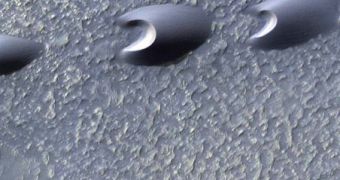NASA's Mars Reconnaissance Orbiter took lately a couple of pictures of the Martian surface revealing some sand dunes, on the Hellespontus region of the planet, looking strikingly similar to a series of hoofmarks. According to NASA, such surface formations have also been spotted on Earth and are called barchan dunes. On Mars, barchan dunes are formed under the action of powerful westerly winds, which shape them into the form of a horseshoe.
The Mars Reconnaissance Orbiter is now in a mission with the role of mapping the surface of the Red Planet, in order for engineers to select future landing sites. Also, last week NASA released two 3D color images of Mars' largest moon, Phobos, a 22 kilometer wide asteroid, dominated by a crater 9.6 kilometers in diameter, dubbed Stickney crater; the other moon asteroid orbiting Mars, Deimos, is only 12 kilometers in diameter.
"Phobos is of great interest because it may be rich in water ice and carbon-rich material," says HiRISE principal investigator from the Lunar and Planetary Laboratory at the University of Arizona, Alfred Mc.Ewen.
Similarly to our Moon, both Phobos and Deimos are tidal locked to Mars, meaning that they only show one face towards the planet, and are partially illuminated by the marsshine, light coming from the Sun and reflected on the surface of the Red Planet. NASA is now trying to determine the types of minerals and soils present on the two small moons of the planet, in hope that one day both Phobos and Deimos could act as landing sites for the first manned mission to the Martian system.
Phobos for example, has a gravitational field one thousand times smaller than that of Earth, which would allow large spacecrafts to lift relatively easy off its surface. Phobos means 'Fear' and Deimos 'Panic' in Greek language. Mars is mostly associated with the Greek god Ares, the God of War. In Greek mythology, Deimos was Ares' son; hence the analogy, Deimos the son of Mars. Both asteroids are believed to have been captured and inserted into a permanent orbit around the planet during fly-bys through its vicinity.

 14 DAY TRIAL //
14 DAY TRIAL //